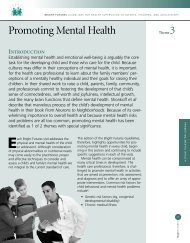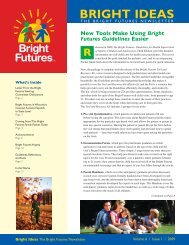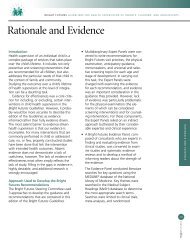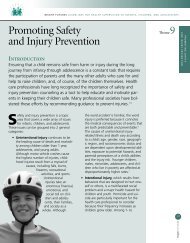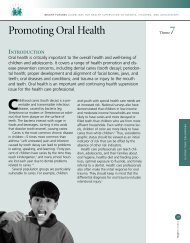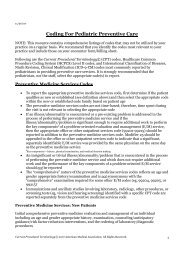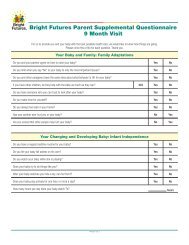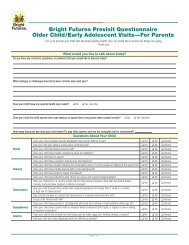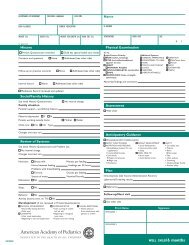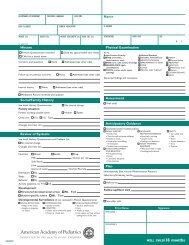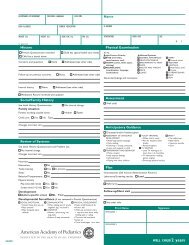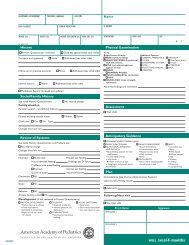POCKET GUIDE - Bright Futures - American Academy of Pediatrics
POCKET GUIDE - Bright Futures - American Academy of Pediatrics
POCKET GUIDE - Bright Futures - American Academy of Pediatrics
Create successful ePaper yourself
Turn your PDF publications into a flip-book with our unique Google optimized e-Paper software.
underweight<br />
■ if BMi is below the fifth percentile, assess for organic disease<br />
and eating disorders.<br />
■ Children with a low BMi may be thin naturally or may<br />
be thin as a result <strong>of</strong> inadequate energy intake, inadequate<br />
food resources, restrictive dieting, a nutritional deficit, or<br />
a chronic disease.<br />
overweight and obesity<br />
■ if BMi is between the 85th and 94th percentiles, the child<br />
is considered overweight and needs further screening.<br />
■ if BMi is at or above the 95th percentile, the child is considered<br />
obese and needs in-depth medical assessment.<br />
iron-Deficiency Anemia<br />
guidelines from the <strong>American</strong> <strong>Academy</strong> <strong>of</strong> <strong>Pediatrics</strong> (AAP)<br />
and the Centers for Disease Control and Prevention (CDC):<br />
■ screen children consuming a strict vegetarian diet without<br />
iron supplementation. (AAP)<br />
■ screen children with known risk factors for iron-deficiency<br />
anemia (low iron intake, special health care needs, previous<br />
diagnosis <strong>of</strong> iron-deficiency anemia). (CDC)<br />
oral health<br />
■ Determine whether the child has regular dental visits.<br />
■ Assess eating behaviors (frequency <strong>of</strong> consuming foods<br />
and beverages high in sugar) to determine the child’s risk<br />
for dental caries (tooth decay).<br />
physical Activity<br />
■ Determine how much physical activity the child engages<br />
in weekly. Compare the child’s physical fitness level with<br />
national standards (school’s standardized physical fitness<br />
assessment).<br />
■ Determine how much time the child spends watching<br />
television and on other media activities (computer, video<br />
games). Determine whether the child watches television<br />
during mealtimes.<br />
Anticipatory Guidance<br />
discuss with Parents, the Child, or both<br />
growth and physical Development<br />
■ expected accelerated growth (for girls at ages 9–11, for<br />
boys at about age 12).<br />
■ Variation in onset <strong>of</strong> puberty among children.<br />
■ upcoming physical changes and specific concerns.<br />
41<br />
<strong>Bright</strong> FUTURES<br />
Middle Childhood



